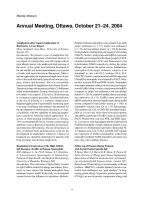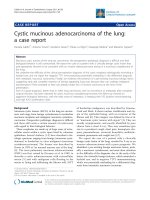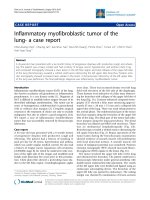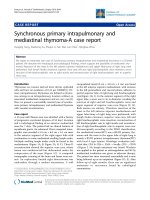Báo cáo y học: "Recurrent, sequential, bilateral deep cerebellar hemorrhages: a case report" pdf
Bạn đang xem bản rút gọn của tài liệu. Xem và tải ngay bản đầy đủ của tài liệu tại đây (656.69 KB, 4 trang )
CAS E REP O R T Open Access
Recurrent, sequential, bilateral deep cerebellar
hemorrhages: a case report
Osama SM Amin
1*
, Raz T Omer
1
, Aso A Abdulla
1
, Raz H Ahmed
2
, Omed Ahmad
1
and Soran Ahmad
1
Abstract
Introduction: Hypertensive intra-cerebral hemorrhage is usually a one-time event and recurrences are rare. Most
recurrences develop as part of long-term failure of blood pressure control. The site of the re-bleed is usually
limited to the basal ganglia and thalami.
Case presentation: We report the case of a 59-year-old hypertensive Caucasian woman who developed two
sequential, right- and then left-sided, deep cerebellar hemorrhages. The second hemorrhage followed the first one
by 57 days, at a time when her blood pressure was optimally controlled. In spite of these critical sites and short
duration between the two bleeds, the patient achieved a relatively good functional recovery. Her brain magnetic
resonance angiogram was unremarkable.
Conclusion: The development of recu rrent hypertensive hemorrhage is rare and usually occurs within two years of
the first bleed. To the best of our knowledge, this is the first reported case of bilateral, sequential, right- and then
left-sided deep cerebellar hemorrhages. These hemorrhages were separated by eight weeks and the patient had a
relatively good functional recovery. We believe that hypertension was the etiology behind these hemorrhages.
Introduction
Hypertensive intra-cerebral hemorrhage is usually a one-
time event and recurrences are rare. Most of these
recurrences develop as part ofafailureofbloodpres-
sure control and within two years of the first hemor-
rhage. The sites of the re-bleed are usually limited to
the basal ganglia and thalami.
Case presentation
A 59-year-old Caucasian woman presented with severe
headache, repeated vomiting, and instability of stance
and gait to our Accident and Emergency (A&E) depart-
ment. She had been experiencing these symptoms for
three hours. The patient had long-standing poorly-con-
trolled essential hypertension, for which she took oral
atenolol. The family denied head trauma or the inges-
tion of other medications. She was drowsy and had a
blood pressure of 210/130 mmHg and a pulse rate of
110 beats per minute. Her lab tests (which included a
coagulation screen) were unremarkable but her
emergency non-contrast brain computed tomography
(CT) scan revealed right-sided acute deep cerebellar
hematoma with mild surrounding edema; no ventricular
dilatation developed (Figure 1). She was manag ed as a
case of primary spontaneous hypertensive intra-cerebral
hemorrhage. During the following two weeks, she
showed a favorable improvement and then she was dis-
charged home on enalapril, metoprolol, hydrochlorothia-
zide, and simvastatin. Her blood pressure was 125/75
mmHg at that time. She was able to stand and walk
with some assistance and her speech was normal. Two
weeks later, the patient came in for a scheduled follow-
up visit. She was conscious and her speech was normal;
she could stand and walk alone, and her blood pressure
was 110/85 mmHg.
Eight weeks later, the patient presented with drowsi-
ness, slurring of speech, vomiting, and inability to sit
and stand unaided for one hour to our A & E. Her
blood pr essure was 190/100 mmHg. Her r outine blood
tests were within their normal reference range. An
emergency non-contrast brain CT scan showed left-
sided acute deep cerebellar hematoma, a contralateral
site to the first hematoma (Figure 2). The patient was
treated medically and improved gradually over a two
* Correspondence:
1
Department of Neurology, Sulaimaniya General Teaching Hospital,
Sulaimaniya City, Iraq
Full list of author information is available at the end of the article
Amin et al. Journal of Medical Case Reports 2011, 5:360
/>JOURNAL OF MEDICAL
CASE REPORTS
© 2011 Amin et al; licensee BioMed Central Ltd. This is a n Ope n Access a rticle dis tributed under t he t erms of t he Creative Commons
Attribution License ( licenses/by/2 .0), which permits unrestricted use, di stribution, and reproduction in
any medium, provided the original work is pro perly cited.
week period. On discharge, her speech was scanning and
her gait was wide-based and ataxic. She could stand and
walk alone with minor assistance. Because of the lack of
expertise in our radiology department, conventional cer-
ebral angiography was not ordered; however, a brain
magnetic resonance angiogram (MRA) was done two
weeks later and the result was unremarkable. We
assume that our patie nt’s hemorrhages were hyperten-
sive in etiology.
Discussion
Mohr et al. [1] analyzed 694 hospitalized stroke patients
and found that intra-cerebral hemorrhage (ICH) is the
third most common cause of stroke; embolic ischemic
stroke and atherothrombotic infarction ranked second
and first on that list of frequency, respectively. ICH con-
stitutes 10% to 15% of all stroke subtypes [2].
Long-standin g arterial hyper tensio n is responsib le for
about 50% of all cases of primary ICH [3], and accord-
ing to Thrift and colleagues [4] this hypertension dou-
bles the risk of developing ICH. The necrotizing effect
of long-standing hypertension on the wall of small pene-
trating blood vessels (<300 μm in diameter) le ads to the
formation of Charcot-Bouchard micro-aneurysms; rup-
ture of the latter leads to intra-parenchymal hemorrhage
[5]. Approximately 20% of hypertensive hemorrhages
develop in the posterior f ossa; the rest are supratento-
rially located. In the cerebellum, the small penetrating
branches of superior cerebellar arteries (and posterior
inferior cerebellar arteries to a lesser extent) on either
side are the usual target for micro-aneurysmal formation
[6-8]. Therefore, most hemorrhages appear in the region
of the dentate nuclei. These cerebellar hemorrhages
account for approximately 5% to 15% of all primary
ICHs [9-12]; the cerebellum is the fourth most commo n
site for spontaneous ICHs, trailing thalamic, lobar, and
putamenal hemorrhages [13].
In 1984, Kunitz and coworkers [14] respectively ana-
lyzed t he NINCDS Stroke Data Bank. Only o ne out of
101 patients with hemorrhagic strokes had a history of
intra-cerebral hemorrhage. Therefore, primary sponta-
neous ICH can be considered a one-time event. Douglas
and Haerer [15] found that hypertensive intra-cerebral
hemorrhages, unlike Berry’ s aneurysms, rarely, if ever,
re-bleed at the same site. On the other hand, patients
are not likely to have a second bleed in another location.
According to Gonzalez-Duarte and colleagues [16],
recurrent hypertensive intra-cerebral hemorrhages do
occur, but at a very low rate, and the main topograp hic
pattern of re-bleeding is basal ganglionic-ganglionic.
Non-hypertensive recurrent hemorrhages tend to be
lobar in location, in contrast to the hypertensive ones.
Bae and associates [17] concluded that the recurrence
rate is 5.4% and that most r ecurrences develop within
Figure 1 Non-contrast brain CT scan of the patient, which was
done approximately four hours after developing her
symptoms. Note that the hematoma lies at the deep right
cerebellar hemisphere and is surrounded by mild cytotoxic edema.
The fourth ventricle was not compressed and brainstem signs were
absent.
Figure 2 Non-contrast brain CT scan of the same patient,
which was done about 2 hours after the re-bleed. The second
hemorrhage lies at the left deep dentate nuclei and is not
surrounded by edema, implying a very recent development. The
first hematoma at the right cerebellar hemisphere had resolved,
leaving a small slit.
Amin et al. Journal of Medical Case Reports 2011, 5:360
/>Page 2 of 4
two years of the first hemorrhage. They also found that
all of these re-bleedings occurred at sites different from
thefirstones,butthemajoritywerewithinthebasal
ganglia and thalami and all were relate d to poor arterial
blood pressure control.
The short-term mortality of recurrent hypertensive
hemorrhages is considerably higher (32%) [ 16] than that
of the first hemorrhages ( 20%) [18]. As f or the long
term functional outcome, Portenoy et al. [19] found that
55% of pat ients achieve a good functional recovery after
sustaining a hypertensive ICH, a figure that falls to 23%
if a recurrence develops [16].
Our patient developed a right-sided deep cerebellar
hemorrhage; the subsequent eight weeks were marked
by a good functional recovery and optimal blood pres-
sure control. Another hemorrhage at the left dentate
nuclei occurred after 57 days and resolved in a relatively
favorable functional independence. Conventional cere-
bral angiography was not done because of the lack of
expertise in our hospital’s radiology department. Brain
MRA after two weeks revealed no vascular anomaly.
Although hypertension is the m ost common etiology
behi nd the development of no n-traumatic intra-cerebr al
hemorrhage in adults [ 3,20,21], the occurrence of recur-
rent hemorrhages should always prompt the physician
to search for an underlying cause(s), such as multiple
ischemic strokes with secondary hemorrhagic transfor-
mation, reperfusion after thrombolytic therapy, exten-
sion from a subarachnoid bleed, vascular anomalies,
tumors, congophilic angiopathy, blood dyscra sias, vascu-
litis, coagulopathy, and illicit drug use [22-27]. Our
patient’ s clinical features, examination, and work-up
have excluded the risk factors listed above.
Conclusion
The develo pment of recurrent hypertensive hemorrhage
is rare and usually occurs within two years of the fir st
bleed. To the best of our knowledge, this is the first
reported case of bilateral, sequential, right- and then
left-sided, deep cerebellar hemorrhage. The hemorrhages
occurred eight weeks apart and she had a relatively good
functi onal recovery. We believe these hemorrhages were
hypertensive in etiology.
Consent
Written informed consent was obtained from the patient
for publication of this case report and any accompany-
ing images. A copy of the written consent is available
for review by the Editor-in-Chief of this journal.
Author details
1
Department of Neurology, Sulaimaniya General Teaching Hospital,
Sulaimaniya City, Iraq.
2
Department of Medicine, Sulaimaniya General
Teaching Hospital, Sulaimaniya City, Iraq.
Authors’ contributions
Clinical management and follow-up was made by OSMA. OA, SA, RHA, RTO,
and AAA examined the patient, took the photos of the brain imaging and
performed the photo editing process. The literature search was done by
OSMA. OSMA wrote the manuscript, and all authors read and approved its
final draft.
Competing interests
The authors declare that they have no competing interests.
Received: 29 January 2011 Accepted: 10 August 2011
Published: 10 August 2011
References
1. Mohr JP, Caplan LR, Melski JW, Goldstein RJ, Duncan GW, Kistler JP,
Pessin MS, Bleich HL: The Harvard Cooperative Stroke Registry: A
prospective registry. Neurology 1978, 28:754-763.
2. Adams HP Jr, Biller J: Hemorrhagic intracranial vascular disease. In Clinical
Neurology. Volume 2. Edited by: Joynt RJ, Griggs RC. Philadelphia: Lippincott-
Raven Publishers; 1993:1-49.
3. Biller J, Shah MV: Intracerebral hemorrhage. In Conn’s Current Therapy.
Edited by: Rakel RE. Philadelphia: WB Saunders; 1997:877-880.
4. Thrift AG, McNeil JJ, Forbes A, Donnan GA: Three important subgroups of
hypertensive persons at greater risk of intracerebral hemorrhage.
Melbourne Risk Factor Study Group. Hypertension 1998, 31:1223-1229.
5. Challa V, Moody D, Bell M: The Charcot-Bouchard aneurysm controversy:
impact of a new histologic technique. J Neuropathol Exp Neurol 1992,
51:264-271.
6. Garcia JH, Ho K: Pathology of hypertensive arteriopathy. Neurosurg Clin N
Am 1992, 3:497-507.
7. McCormick WF, Rosenfield DB: Massive brain hemorrhage: a review of
144 cases and an examination of their causes. Stroke 1973, 4:949-954.
8. Dinsdale HB: Spontaneous hemorrhage in the posterior fossa: A study of
primary cerebellar and pontine hemorrhage with observations on the
pathogenesis. Arch Neurol 1964, 10:200-217.
9. Freeman RE, Onofrio BM, Okazaki H, Dinapoli RP: Spontaneous
intracerebellar hemorrhage. Neurology 1973, 23:84-90.
10. Hyland HH, Levy D: Spontaneous cerebellar hemorrhage. Can Med Assoc J
1954, 71:315-323.
11. Rey-Bellet J: Cerebellar hemorrhage: A clinicopathologic study. Neurology
1960, 10:217-222.
12. Brennan RW, Bergland RM: Acute cerebellar hemorrhage: Analysis of
clinical findings and outcome in 12 cases. Neurology 1977, 27:527-532.
13. Weisberg LA, Stazio A, Shamsnia M, Elliott D: Nontraumatic parenchymal
brain hemorrhages. Medicine (Baltimore) 1990, 69:277-295.
14. Kunitz SC, Gross CR, Heyman A, Kase CS, Mohr JP, Price TR, Wolf PA: The
Pilot Stroke Data Bank: Definition, design and data. Stroke 1984,
15:740-746.
15. Douglas MA, Haerer AF: Long-term prognosis of hypertensive
intracerebral hemorrhage. Stroke
1982, 13:488-491.
16.
González-Duarte A, Cantú C, Ruiz-Sandoval JL, Barinagarrementeria F:
Recurrent primary cerebral hemorrhage: Frequency, mechanisms, and
prognosis. Stroke 1998, 29:1802-1805.
17. Bae H, Jeong D, Doh J, Lee K, Yun I, Byun B: Recurrence of bleeding in
patients with hypertensive intracerebral hemorrhage. Cerebrovasc Dis
1999, 9:102-108.
18. Dixon AA, Holness RO, Howes WJ, Garner JB: Spontaneous intracerebral
hemorrhage: an analysis of factors affecting prognosis. Can J Neurol Sci
1985, 12:267-271.
19. Portenoy RK, Lipton RB, Berger AR, Lesser ML, Lantos G: Intracerebral
hemorrhage: a model for the prediction of outcome. J Neurol Neurosurg
Psychiatry 1987, 50:976-979.
20. Sessa M: Intracerebral hemorrhage and hypertension. Neurol Sci 2008,
29(Suppl 2):S258-S259.
21. Potter JF, Robinson TG, Ford GA, Mistri A, James M, Chernova J, Jagger C:
Controlling hypertension and hypotension immediately post-stroke
(CHHIPS): a randomised, placebo-controlled, double-blind pilot trial.
Lancet Neurol 2009, 8(1):48-56.
22. Mullins ME, Lev MH, Schellingerhout D, Gonzalez RG, Schaefer PW:
Intracranial hemorrhage complicating acute stroke: how common is
hemorrhagic stroke on initial head CT scan and how often is initial
Amin et al. Journal of Medical Case Reports 2011, 5:360
/>Page 3 of 4
clinical diagnosis of acute stroke eventually confirmed? AJNR Am J
Neuroradiol 2005, 26(9):2207-2212.
23. Dubey N, Bakshi R, Wasay M, Dmochowski J: Early computed tomography
hypodensity predicts hemorrhage after intravenous tissue plasminogen
activator in acute ischemic stroke. J Neuroimaging 2001, 11(2):184-188.
24. Thrift AG, Dewey HM, Macdonell RA, McNeil JJ, Donnan GA: Incidence of
the major stroke subtypes: initial findings from the North East
Melbourne stroke incidence study (NEMESIS). Stroke 2001,
32(8):1732-1738.
25. Thrift AG, Donnan GA, McNeil JJ: Epidemiology of intracerebral
hemorrhage. Epidemiol Rev 1995, 17(2):361-381.
26. Auer RN, Sutherland GR: Primary intracerebral hemorrhage:
pathophysiology. Can J Neurol Sci 2005, 32(Suppl 2):S3-12.
27. Donnan GA, Fisher M, Macleod M, Davis SM: Stroke. Lancet 2008,
371:1612-1623.
doi:10.1186/1752-1947-5-360
Cite this article as: Amin et al.: Recurrent, sequential, bilateral deep
cerebellar hemorrhages: a case report. Journal of Medical Case Reports
2011 5:360.
Submit your next manuscript to BioMed Central
and take full advantage of:
• Convenient online submission
• Thorough peer review
• No space constraints or color figure charges
• Immediate publication on acceptance
• Inclusion in PubMed, CAS, Scopus and Google Scholar
• Research which is freely available for redistribution
Submit your manuscript at
www.biomedcentral.com/submit
Amin et al. Journal of Medical Case Reports 2011, 5:360
/>Page 4 of 4









